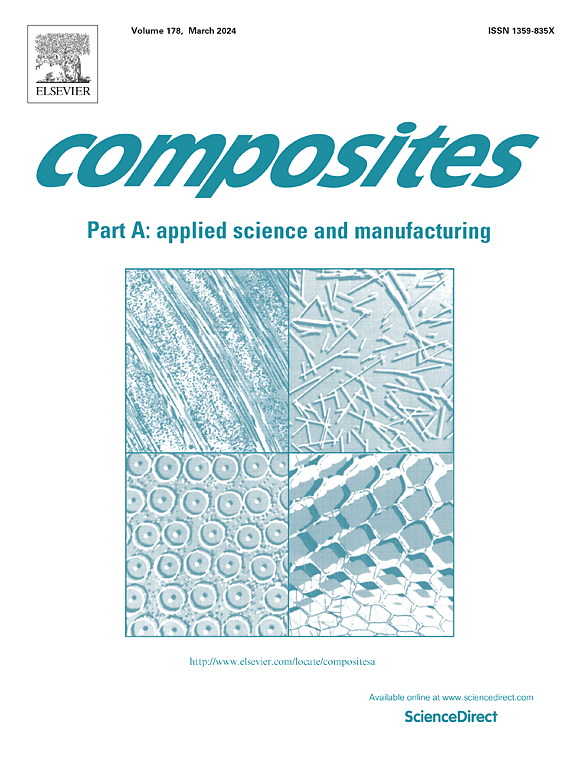Simultaneous enhancement of mechanical robustness and self-sensing performance in fly ash-based geopolymer nanocomposites
IF 8.1
2区 材料科学
Q1 ENGINEERING, MANUFACTURING
Composites Part A: Applied Science and Manufacturing
Pub Date : 2025-04-02
DOI:10.1016/j.compositesa.2025.108894
引用次数: 0
Abstract
The simultaneous enhancement of both mechanical robustness and self-sensing capabilities in geopolymer nanocomposites significantly advances the precision and dependability of structural health monitoring systems. In this study, the uniform dispersion of graphene nanoplatelets (GNPs) within fly ash-based geopolymer composites is successfully achieved through the in-situ chemical synthesis of a silica (SiO2) coating on the GNP surface. The resulting composite material exhibits a significant enhancement in sensitivity, which is attributed to the presence of the SiO2 coating on the GNPs. In comparison to uncoated GNP/geopolymer composites, varying the concentration of the precursor tetraethyl orthosilicate (TEOS) from 0 to 8 ml enables the formation of SiO2 coatings with different thicknesses, which effectively modulates the resistivity of the composite to meet specific sensing application requirements. The self-sensing sensitivity of the composite shows a considerable increase of 479.7 %, accompanied by a concurrent 89.1 % increase in elastic modulus. Notably, the gauge factor (GF) of geopolymer composites reached up to 491, which surpasses the results reported in recent literatures. The underlying mechanism suggests the in-situ SiO2 coating significantly enhances the composite’s sensitivity and mechanical properties by improving the interface bonding between GNP and the geopolymer matrix, acting as a dielectric layer to reduce direct contact and particle agglomeration, and exhibiting excellent chemical and thermal stability. This advancement holds paramount importance in mitigating risks associated with structural failures, prolonging the operational lifespan of critical infrastructure, and ultimately improving public safety standards.
粉煤灰基地聚合物纳米复合材料机械鲁棒性和自传感性能的同时增强
地聚合物纳米复合材料的机械鲁棒性和自感知能力同时增强,显著提高了结构健康监测系统的精度和可靠性。在本研究中,通过在GNP表面原位化学合成二氧化硅(SiO2)涂层,成功地实现了石墨烯纳米片(GNPs)在粉煤灰基地聚合物复合材料中的均匀分散。结果表明,复合材料的灵敏度显著提高,这是由于在GNPs上存在SiO2涂层。与未涂覆的GNP/地聚合物复合材料相比,改变前驱体正硅酸四乙酯(TEOS)的浓度从0到8 ml,可以形成不同厚度的SiO2涂层,有效地调节复合材料的电阻率,以满足特定的传感应用要求。复合材料的自感灵敏度提高了479.7%,同时弹性模量提高了89.1%。值得注意的是,地聚合物复合材料的规范因子(GF)高达491,超过了最近文献报道的结果。其机理表明,原位SiO2涂层通过改善GNP与地聚合物基体之间的界面结合,作为介电层减少直接接触和颗粒团聚,并表现出优异的化学和热稳定性,显著提高了复合材料的灵敏度和力学性能。这一进步对于降低与结构故障相关的风险、延长关键基础设施的使用寿命以及最终提高公共安全标准至关重要。
本文章由计算机程序翻译,如有差异,请以英文原文为准。
求助全文
约1分钟内获得全文
求助全文
来源期刊

Composites Part A: Applied Science and Manufacturing
工程技术-材料科学:复合
CiteScore
15.20
自引率
5.70%
发文量
492
审稿时长
30 days
期刊介绍:
Composites Part A: Applied Science and Manufacturing is a comprehensive journal that publishes original research papers, review articles, case studies, short communications, and letters covering various aspects of composite materials science and technology. This includes fibrous and particulate reinforcements in polymeric, metallic, and ceramic matrices, as well as 'natural' composites like wood and biological materials. The journal addresses topics such as properties, design, and manufacture of reinforcing fibers and particles, novel architectures and concepts, multifunctional composites, advancements in fabrication and processing, manufacturing science, process modeling, experimental mechanics, microstructural characterization, interfaces, prediction and measurement of mechanical, physical, and chemical behavior, and performance in service. Additionally, articles on economic and commercial aspects, design, and case studies are welcomed. All submissions undergo rigorous peer review to ensure they contribute significantly and innovatively, maintaining high standards for content and presentation. The editorial team aims to expedite the review process for prompt publication.
 求助内容:
求助内容: 应助结果提醒方式:
应助结果提醒方式:


